
Kohomba Kankariya Ritual
Selections
8:35 min.
Although the Kohomba kankariya is a ritual of propitiation for the local Kandyan deities, the Kohomba gods, it is also a rite of healing, performed to restore the sense of communitas, to alleviate social tensions, and to ensure the well-being and prosperity of the land and its people. Traditionally, villagers contributed with offerings of flowers, fruits, camphor, oil lamps, cloth for the canopy, and banana trunks for the altars that were erected for the gods. Such communal events were extremely rare when the study was conducted in the 1980s.
The ritual's origin myth, the myth of Vijaya and Kuveni, remains deeply significant for Sinhalas. Vijaya, an Indian prince of noble descent is banished from the kingdom and lands on the shores of Lanka, where he meets and falls in love with Kuveni, an indigenous princess. After he abandons her to marry an Indian princess of royal descent, Kuveni curses Vijaya and kills him. The curse, however, haunted Kuveni's descendants for many generations. The Kohomba kankariya is considered to be a reenactment of a ritual performed to heal Panduvas, a descendant of Kuveni and of one of Lanka’s first kings, of afflictions he suffered because of Kuveni's curse. The yakdessa's ornaments are considered to be half of those worn by the healer-king Malaya, whose curing of Panduvas in the fifth century BCE is the culminating act in the myth of the kankariya.
The kankariya consists of more than thirty discrete acts and includes the building of the ritual hall and altars, offerings to the gods, solo and group dancing, drumming, chanting, comedy and dramas. The ritual presented in the video features one of the most esteemed ritual masters of the twentieth century, the late Tittapajjala Yakdessalage Suramba.
This film includes a selection from the complete performance featured in the DVD companion to Reed's book. The video opens with a short introduction to the Kohomba kankariya ritual, its origin myth, and a summary of the performance's main features. This is followed with extracts from three sections of the ritual ceremony: Yak Anuma or Dance of Invitation to the Deities, Kuveni Asna or the Lament of Kuveni, and Ek Talaya (sections 6, 7 and 9 of the 10 included in the complete video).
Recorded in Kandy, Sri Lanka, July 1988.
Directed by Wilton Martinez / Production: Susan A. Reed and Wilton Martinez
Research: Susan A. Reed / Written & Narrated by Susan A. Reed
Camera & Sound: Susan A. Reed / Editing & DVD Authoring: Wilton Martinez
Funding & support: National Science Foundation, Bucknell University, Society of Dance History Scholars
Distributed by The University of Wisconsin Press
Duration: 58 minutes
This video is recommended for teaching about subjects including:
ritual and symbolism
myth and religion
dance and performance
ethnomusicology
Sinhala cultural and national identity
Southeast Asian studies
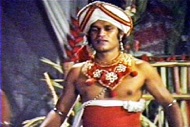
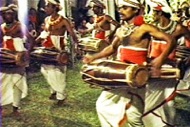


For centuries the Kohomba kankariya was the most important ritual in Kandyan villages. Led by the yakdessas, hereditary dancer-priests of the berava drummer caste, the ceremony was performed during several days as a thanksgiving, a forgiving, or a postharvest celebration. By the mid-1950s, however, the traditional kankariya had vanished in most areas of the Kandyan region and became a "museum piece," a national symbol of Sinhala cultural heritage. The ritual presented in the video was sponsored and documented by anthropologist Susan A. Reed in 1988. (continues below)
For more information and to purchase Dance and the Nation, please contact The University of Wisconsin Press

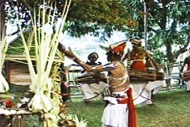
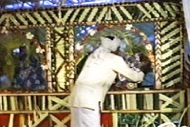
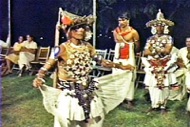
Documentary
Advocacy
Creative
EthnoVisions


